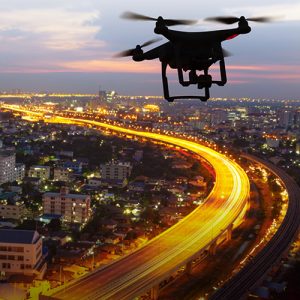 Soon, deliveries sent via flying drones will be waiting for you when you come home from work. The next time your roof leaks, the roofer will send up a drone to analyze the problem. Want a bird’s-eye view picture of your summer barbecue? Up goes a drone.
Soon, deliveries sent via flying drones will be waiting for you when you come home from work. The next time your roof leaks, the roofer will send up a drone to analyze the problem. Want a bird’s-eye view picture of your summer barbecue? Up goes a drone.
Technology is moving faster than most of us, and it looks like drones, or unmanned aircraft systems (UAS), are becoming the next big thing.
Like any new capability, there is good and bad. On the good side, drones can be used at massive airports like LAX to do things that previously caused lengthy disruptions to air traffic and inconvenienced passengers. Now, when a runway needs to be shut down for maintenance, the front-end work of taking pictures and assessing damage can be done by a drone, cutting back on downtime and bringing more accurate information to the process.
Most relevantly to LAAPOA, airport police will be able to use drones to determine the extremity of safety situations. Drones can be used to give situational awareness, particularly in areas where police don’t have eyes. While the public safety capabilities are only recently being thought through, all of us in the airport law enforcement field look forward to using drones as another tool in our arsenal. At the same time, however, we are also seriously considering the other side — drones have been used internationally to carry payloads from hand grenades in the Middle East to chemical weapons in Syria. We have never seen the likes of the damage UAS can cause and the ability of a perpetrator to vanish in our country.
U.S. airports are rising to address the threat, one that the perpetrator can set in motion outside the confines of the airport and then walk away without leaving a trace. Currently, the FAA is requiring UAS operators to register their drones. They are also taking many steps to deter UAS operators from flying too closely to airports. The FAA’s Remote ID will be required in future drones, and a UAS Traffic Management (UTM) system will be established to help manage UAS traffic. Currently, if you own a UAS in America and it is near a no-fly zone, you won’t be able to operate it there. However, there are many ways to easily circumvent the system. Just like how your kids can override parental TV controls, bad guys can figure out how to rig a drone to fly anywhere in less than five minutes.
There is also another wrinkle to consider here. DJI, the U.S. market leader in drone sales, is a Chinese company that has access to the coordinates its drones capture, as well as pictures and video. The U.S. Department of Defense (DOD) is so concerned with data collection and control capabilities of DJI drones that it has banned the entire department from using DJI drones.
So, when we — police at airports that are considered to be high terrorist targets — started talking about counter-UAS solutions (c-UAS), we came up with the following criteria: be able to identify the ground operator and the drone, have the ability to pull forensics (for prosecution purposes), the c-UAS system should not be dependent on user or manufacturer compliance and, certainly, a Chinese drone manufacturer should not be providing c-UAS systems, as this would be more dangerous than them providing the drones themselves.
We don’t want China or any other foreign drone manufacturer to be capable of gathering the knowledge associated with sensitive counter-drone coordinates and how and why a c-UAS system is set up. Sure, they can make some guesses through the information they are mining via their drones, but it is irresponsible and dangerous for DJI or any other foreign entity to have inside information on c-UAS. The alarm bells that the DOD has been ringing should be heard from sea to shining sea on c-UAS systems in America — no DJI AeroScope c-UAS system. No foreign systems. We need protection.
Thankfully, L.A. Mayor Eric Garcetti, Deputy Mayor Jeff Gorell, LAWA CEO Deborah Flint, LAWA Deputy Executive Director for Homeland Security/Public Safety Pat Gannon and LAWA CTO Justin Erbacci are working hard to have LAX be the first airport in the U.S. to set up a c-UAS system to thwart these threats. They have a vision. Let’s not forget, Mayor Garcetti and Deputy Mayor Gorell served together in the Navy. It looks like LAWA has a strong team that is committed to furthering the gold standard marker that LAX strives for. By being the first to set up a counter-UAS system that will protect our airport from drones that are quickly being used in new and innovative ways, LAWA is looking ahead and not chasing from behind. We applaud them.
